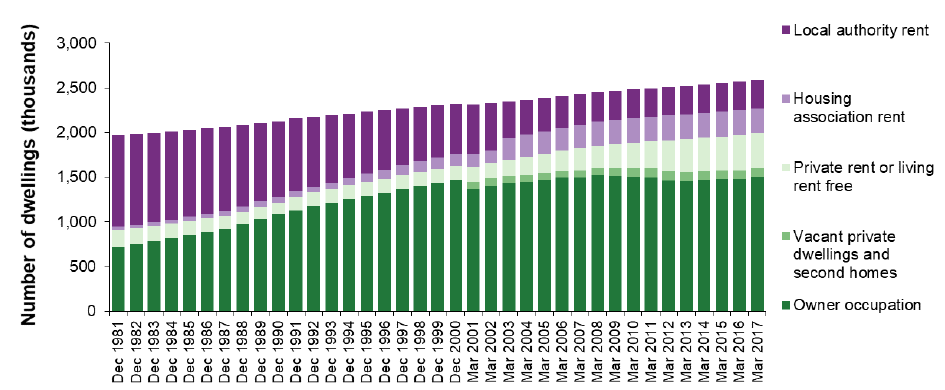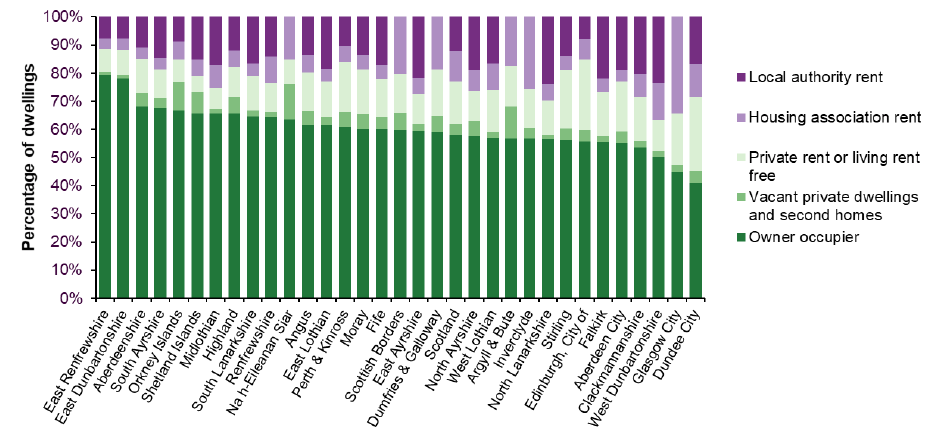Housing statistics 2018: key trends summary
Annual statistics up to 31 March 2017 on total new housing supply in Scotland across all sectors, along with information on various elements of local authority housing such as stock, lettings, house sales, evictions, housing lists, and housing for older people and people with disabilities.
Stock by Tenure
In 1981, less than 40% of dwelling stock (0.72 million dwellings) was owner occupied. By 2000 this had risen to 63% (1.47 million) although the proportion has fallen again in the last few years so that, in 2017, 58% (1.50 million) of dwelling stock was owner occupied (excluding vacant private dwellings and second homes).
The number of dwellings in Scotland has increased by 615,000 in the last 3 and a half decades from 1.97 million in 1981 to 2.59 million in 2017. This has coincided with an increasing Scottish population and the increased prevalence of smaller households[2].
Two factors have contributed to the shift toward owner occupation: the introduction of the right to buy for public authority tenants in 1979 coupled with the decline of local authority new build, and the increased contribution of private sector house building. Chart 6a illustrates the changes in the size of private rented sector stock, compared with councils and housing associations over the time period from 2001 to 2017.
Chart 6a: Numbers of stock by private rented, council housing, and housing associations, 2001 to 2017

The reduction in owner occupation between 2008 and 2014 has coincided with an increase in the number renting privately or living rent free from 10% (around 248,000 dwellings) in 2008 to 15% (around 382,000 dwellings) in 2015, as shown in Chart 6b. This may have been partly caused by the economic downturn and the difficulty potential home owners have subsequently experienced in securing a mortgage. In the latest year however, the proportion renting privately or living rent free has remained at a similar level of 15% (393,000 in 2017).
Chart 6b: Estimated stock of dwellings by tenure, 1981 to 2017

Local authority level tenure estimates are shown in Chart 7. The rate of owner occupation varies from 79% in East Renfrewshire to 41% in Dundee. In general, as expected, cities have lower owner occupation rates. The proportion of dwellings rented privately ranges from 6% in the Shetland Islands to 26% in Dundee, with cities tending to have higher rates of households in the private rented sector. Percentages of households that are social renting range from 12% in East Renfrewshire and East Dunbartonshire to 34% in Glasgow and 37% in West Dunbartonshire.
Chart 7: Tenure in Scotland by local authority 2017

Link to tenure tables: http://www.scotland.gov.uk/Topics/Statistics/Browse/Housing-Regeneration/HSfS/KeyInfo
The Scottish Household Survey website presents information on housing stock by tenure. Chapter 3 on Housing contains tables on tenure of household by year and by household age group: http://www.gov.scot/Topics/Statistics/16002/PublicationAnnual
Statistics on housing stock in the other UK nations can be found through the following link to the Ministry of Housing, Communities and Local Government website: http://www.communities.gov.uk/housing/housingresearch/housingstatistics/housingstatisticsby/stockincludingvacants/livetables/
Contact
Katrina Caldwell: housing.statistics@gov.scot
There is a problem
Thanks for your feedback